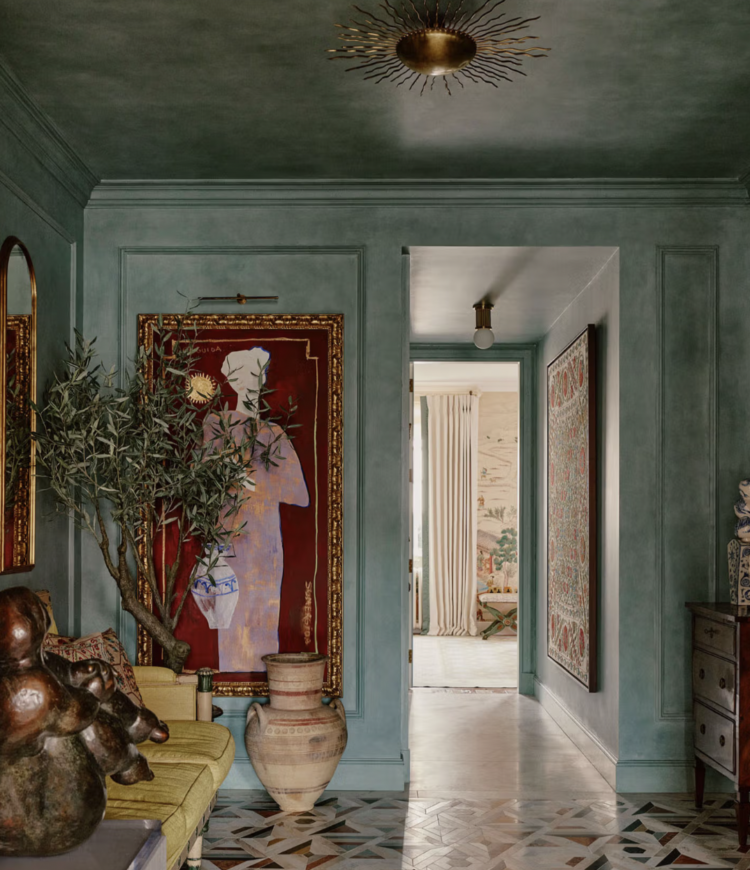Style manifested in many forms over the last 12 months, as well as in our homes and gardens with the way we decorate, entertain, and live. Of course style – and trends – are subjective, not to mention a subject of heated discussion – but each of the trends we discuss for the year ahead will make us look, and think about the ways we design or the approaches we take to personal style in the places we inhabit.
It’s important to know that not everything new becomes a trend.
The factors that drive a trend are much bigger than individual preferences or desires. They are powerful enough to change values and life goals, originating long before the trend impacts the mainstream.

Light blues and other natural wonders like emerald and sage will remain timeless favourites, while edgier folk will start experimenting with rust and red tones for a bolder look. Pictured: Belgravia Jewel Box by Studio Ashby, www.studioashby.com
TikTokificaton has spawned an endless stream of interior trends. But what’s the real difference between what’s trending and trend forecasting? A TikTok trend can be a knee-jerk reaction or a fleeting moment, while trend forecasting is supported with extensive data and expert analysis. Read more, ‘The Big Picture Design Trends That are Taking off Right Now.’
In our 2025 Interior design forecast, we’ll explore influential factors like sensorial design to discreet tech, and consider the impact they will have on the spaces we inhabit.
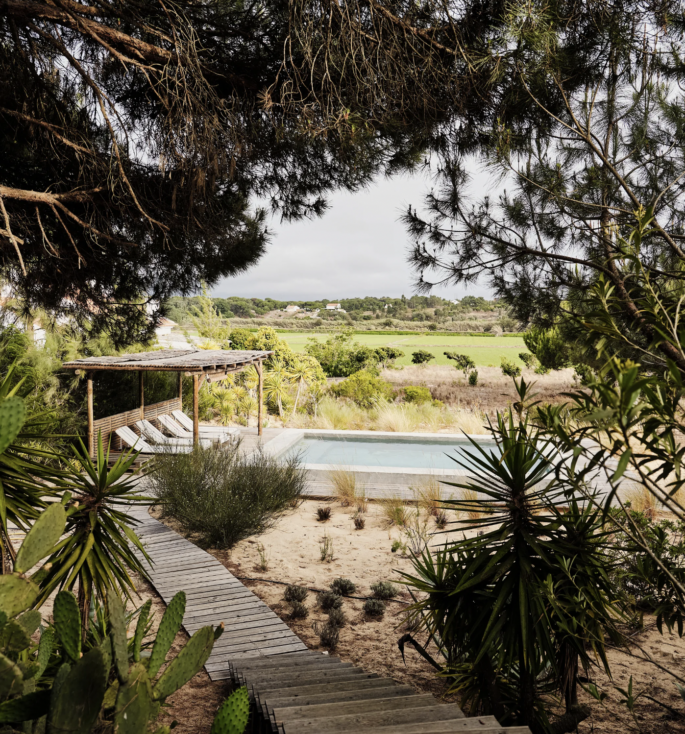
Designers will be focusing more than ever on creating beautiful spaces that are also kind to the planet. Pictured: Textile designer Carolina Irving’s Portuguese house via houseandgarden.co.uk.
In a time of economic uncertainty and existential woe, WGSN’s newly-released Home Lifestyles 2025 Paper predicts a period of necessary innovation as we continue to “do more—and expect more—from the spaces we live in.”
Organised around our growing desire to live intentionally, work dynamically, rest restoratively, and play immersively, the all-encompassing report has plenty of takeaways for forward-thinking designers looking to stay ahead of the curve. Here’s a closer look at some of the emerging design trends that could well become commonplace by 2025. Read more, ‘The 21 Design Trends That have Stood the Test of Time.’
The last few years have led to significant changes in what people want from both the form and function of the home. What design trends do the next few years have in store?
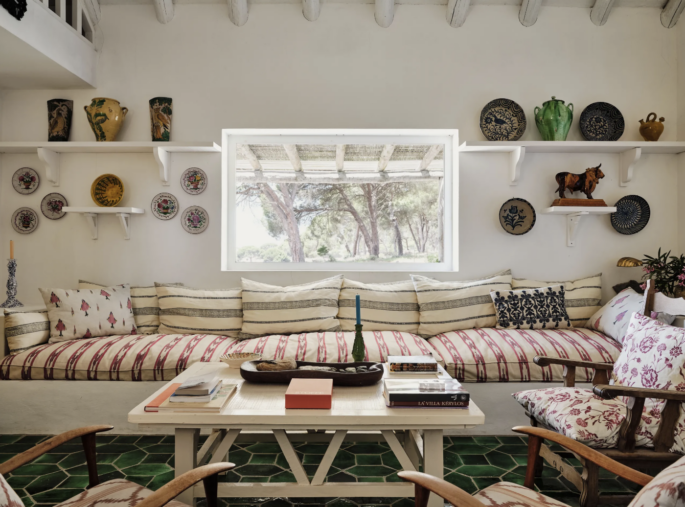
Creating a welcoming environment is key, as is designing spaces that accommodate multiple people at once such as doyenne of fabric, Carolina Irving’s Portuguese house featured in houseandgarden.co.uk.
2025 PREDICTIONS ARE IN
However the future might feel at the moment, the online marketplace 1stDibs has eyes on how it will look. Annually, the site takes a look at the year ahead—surveying more than 600 interior designers and offers their insights to the rest of us. Here’s what’s to come, and what’s on the wane, for the new year.
The rise of discreet tech
As homes have gotten smarter, they’ve also become more cluttered with tech. A novel solution that WGSN’s consumer technology team sees taking hold is the move towards discreet design, which sees gadgets forgoing sleek shininess in favour of an aesthetic that can blend in with decor. A domesticated design approach ‘softens’ tech products to make them feel less obtrusive and more blended into the home environment,” says Lisa Yong, WGSN’s director of consumer technology. “User interfaces for home tech products are also moving away from screen-based interactions to more intuitive controls that follow the principles of calm technology.”
Discreet tech means incorporating smart home devices in a way that they blend effortlessly with the decor.
Technology continues to advance, and in 2025, it will become even more seamlessly integrated into our homes. Hidden speakers, wireless charging furniture, security devices that mimic minimalist toys to disguise their true purpose, voice-controlled lighting, and designs with integrated screens that go invisible when turned off are just a few examples.
AD Pro’s 2025 Interior Design forecast predicts something similar, reporting the home-tech products worth the spend in 2025 “must offer whole-home, and homeowner, benefits: improving security, health, and comfort while being a discreet addition to a home’s design. Even better if they can all be managed with one user-friendly voice- or app-controlled platform to cut down on the number of required updates. In 2025 and beyond, the home tech that designers recommend is all about ease.”

There is never any substitute for clever, thoughtful and intentional design that rests on quality. Pictured: Belgravia Jewel Box by Studio Ashby, www.studioashby.com
Sensorial Design will become the norm
Perhaps related on some level to the craving for comfortable furniture, the concept of the sensorial home will be pleasing to more than just our eyes in the years ahead. There is a wonderful opportunity to address sensorial design from the very beginning with walls, floors, and large surfaces that touch multiple senses. This means visually vibrant materials that both show texture and thrill the fingertips. Wood definitely ticks this box, like the sandblasted wood that has both visual and tactile rings and can bring subtle fragrance into a room, or reeded glass that provides visual plays of transparency and texture. Fragrance and how a space smells is getting more attention, too.
Eco-friendly living
Sustainability remains at the forefront of interior design trends in 2025. Designers will be focusing more than ever on creating beautiful spaces that are also kind to the planet.
Vegan leathers, non-toxic materials, reclaimed wood and eco-friendly products are not just options but essentials.
In addition, look around for reusable and repurposable items (including buildings) to reduce the need for frequent replacements. It’s a creative way to reduce waste and preserve architectural heritage while making a stylish statement. Incorporating energy-efficient appliances and fixtures also helps.
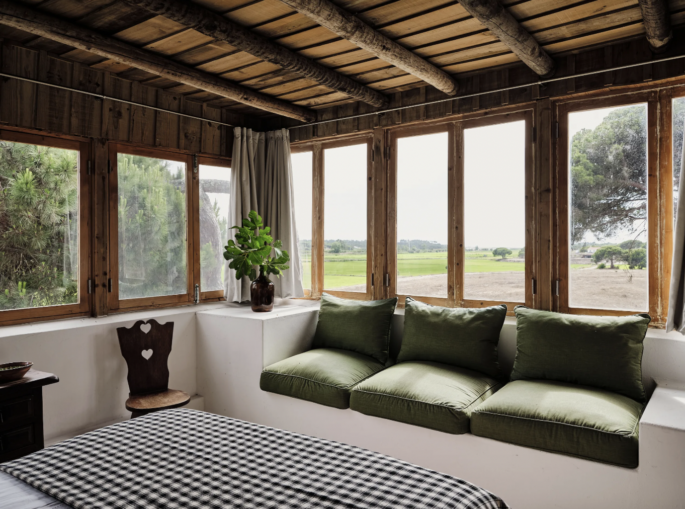
Warm and darker-toned timbers are here to stay. Pictured: Carolina Irving’s Portuguese house, houseandgarden.co.uk
Shower rooms
While light and airy showers with frameless glass enclosures continue to be popular, but some homeowners prefer more privacy. The shower room style of shower has a glass door leading into a fully enclosed space that creates an intimate, spa-like look and feel. And the beauty of this type of shower is the ability to incorporate such features as a steam or sauna, as well as aromatherapy and chromotherapy. With a powerful ventilation fan, a shower room can keep moisture contained, instead of it spreading to other areas of a bathroom.
All about well-being
At home, health-centered technologies are also here to stay—whether they take the form of a sauna, cold plunge pool, or something more elemental, like an air filtration system. There is a huge focus on wellness tech with installation of air purification systems, circadian lighting that follows the body’s natural rythyms, and water filtration as standard features that have real, long-lasting benefits. Increasingly popular, touch-less faucets offer similar cleanliness and environmental advantages, with lots more residential options available.
Eco-driven
One of the most prominent and enduring concerns of the entire design industry is sustainability, both in terms of building materiality and how long items in the home will last for.
From a design perspective, it’s about buying secondhand, sourcing investment pieces and choosing materials that are durable and long-lasting.
After a few years of supply-change disruptions, and with uncertain environmental futures approaching, 1st dibs latest trend survey reveals designers say 43% of projects will have at least some kind of sustainability requirement in 2025. And while 35% of designers plan to integrate discreet tech into homes, a full-throated resistance to AI continues: 60% say they are uncertain or uninterested in AI-powered processes as they prefer human touch and sustainability.
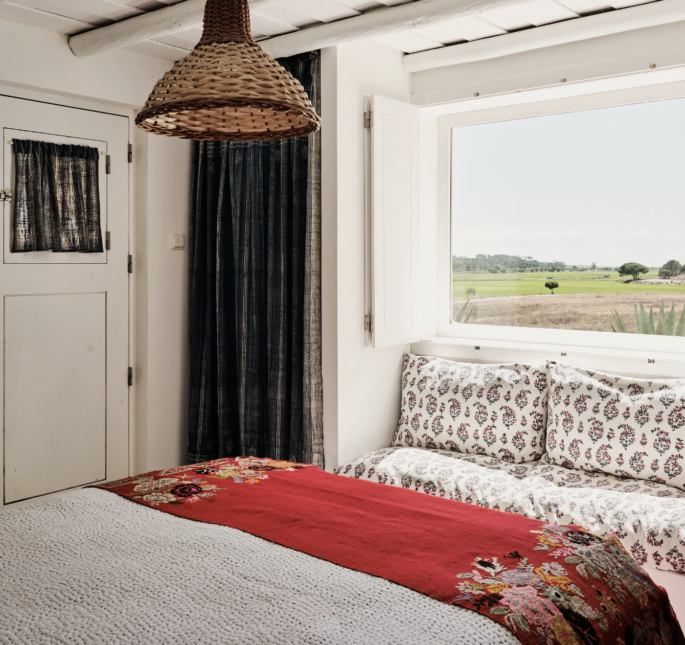
From a design perspective, it’s about buying secondhand, sourcing investment pieces, and choosing materials that are durable and long-lasting. Pictured: Carolina Irving’s Portuguese house, houseandgarden.co.uk
Quality first
There is never any substitute for clever, thoughtful and intentional design that rests on quality. Many designers noted a shift towards collecting. The new year will see an increased appreciation for investment furniture and art, that will keep classic profiles and pieces current for years to come.
Quality and robust materials will always carry through year on year, as their embedded authenticity and the craftsmanship required to work with such materials transcends time.

Quality and robust materials will always carry through year-on-year. Pictured: Belgravia Jewel Box by Studio Ashby, www.studioashby.com
Deep in the woods
Warm and darker-toned timbers are here to stay. If you hadn’t already noticed, the return of dark mahogany or rich darker walnut tones has been creeping into our homes for a while now, thanks to the embrace of vintage and antiques. Some believe we’re trending hard against the cold Hamptons look that has been popular for so long with wood-wrapped rooms that are surprisingly warm and comforting. And forget streamlined wood dining chairs, chunky timber dining seating is in. Any kind of chair that looks hand-carved or a bit sculptural will do.
The entertainer
There’s a renewed interest in entertaining at home, with guest rooms now designed as immersive experiences that make visitors feel like they’re staying somewhere truly special. Creating a welcoming environment is key, as is designing spaces that accommodate multiple people at once. People want to bring a more adventurous spirit into their homes, specifically in spaces where entertaining is a key focus.
Blame the cost of living, but many designers are predicting a renewed appreciation for hosting dinner parties and small get-togethers at home.
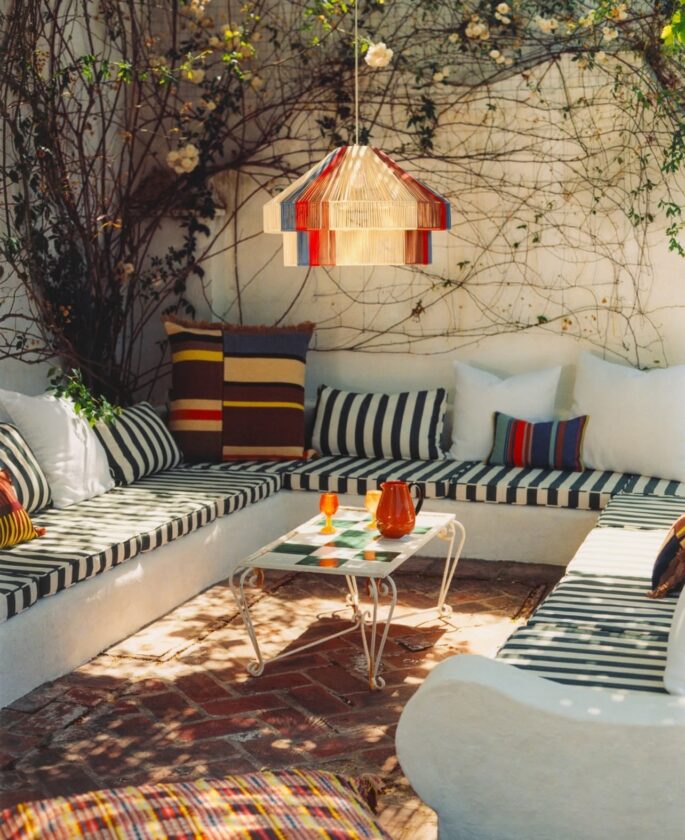
People want to bring a more adventurous spirit into their homes, specifically in spaces where entertaining is a key focus. Photo: Zara Home UK
What’s your passion?
Like individualism, homeowners are seeking a sense of personal freedom in the places they live – with an increasing request for purpose-driven, separate spaces. These bespoke moments are dedicated to people’s passions—whether it’s for culinary pursuits, creative hobbies, or wellness. It might be a separate area for imbibing wine, practising Pilates or entertaining guests for clients. Designers see this push, enduring well into 2025 and beyond, as we collectively become increasingly aware of our sensory and environmental needs. Read more, ‘Can You Design A Happy Home? It’s Easier Than It Looks.’
What’s In
Earthen hues will dominate in the new year. Members of the “millennial grey” cult beware: this earthy colour design direction is something we’ll be witnessing even more of in 2025, which is great because earthy, nature-inspired colours are easy to live with and have staying power. Warm chocolate brown is officially the most popular colour for 2025. The percentage of designers favouring it almost doubled last year. The appeal of dark brown and burgundy almost tripled from 2024, from 7% to 20%.
Also resonating? Light blues and other natural wonders like emerald and sage will remain timeless favourites, while edgier folk will start experimenting with rust and red tones for a bolder look.

Quality and robust materials will always carry through year on year, as their embedded authenticity and the craftsmanship required to work with such materials transcends time. Pictured: Belgravia Jewel Box by Studio Ashby, www.studioashby.com
Looking to the Past—Especially the ’20s and ’30s
Designers often look back to look ahead. “I love that more than 80% of our designers are sourcing pieces from the 1920s through the ’90s,” says Anthony Barzilay-Freund, 1stDibs’ editorial director and director of fine art.
“This confirms my personal belief that every room needs at least one antique or vintage piece of furniture or object to really make it sing.” A full 62% of designers expect to shop antiques, as opposed to 2024’s 56% rate, a four-year high.
Animal nature
Tigers will show their stripes more than ever in 2025. Designers predict packs of bold aesthetics: 33% say maximalism or eclecticism will dominate, followed by 31% for organic modernism. Animal prints are ticking upwards, too, rising in support to 6% from last year’s 4%. And a jungle of eye-popping styles will join them, with designers taking on colourful painted murals (28%), patterned wallpaper (26%), and wallpapered ceilings (26%).
Flower power
Interiors will be in full bloom in 2025, as organic patterns and motifs like botanicals remain the most-requested aesthetic. That said, large-scale florals are starting to see a slight dip from last year, with demand dropping six points from 2024 to 15% for 2025. Read more, ‘9 Design Trends We Will Be Seeing In The Very Near Future.’
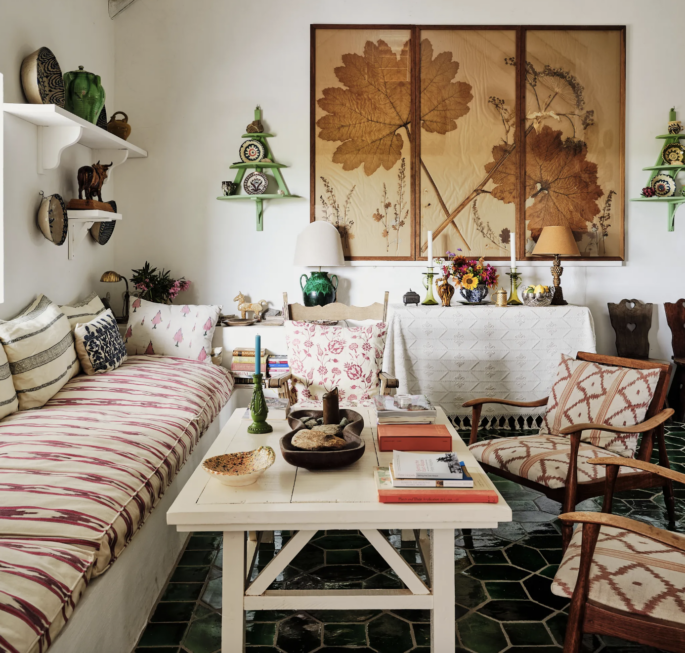
Any kind of chair that looks hand-carved or a bit sculptural will do. Pictured: Carolina Irving’s Portuguese house, houseandgarden.co.uk
Classic glass lighting
Lighting design has seen a huge shift in recent years, with renewed interest in blown-glass confections. Another surprise is that when asked what iconic lighting style or design will be popular in the coming year, the top choice was Murano glass pendants, garnering a nod from 27% of our respondents (significantly up from last year’s 19%).”
Turns out the ancient Italian technique is the bright idea for 2025.
A good year for kitchen renovations
Designers expect 2025 to be a big year for kitchens, with up to 61% of homeowners renovating, up from 54% last year. They also anticipate some 45% of clients will request scullery and outdoor kitchen areas. While living spaces have softened from 62% to 51%, there’s been a, well-striking interest in home bowling alleys, with double the number of designers recommending them to clients for 2025.
Metals that breathe, age and don’t always match
Parallel with nature-informed hues, people are leaning into living, breathing materials, like unlacquered brass, as well as mixing metals. Until relatively recently, you would have a room with all brass plumbing fixtures, and everything had to be brass. That’s not the case anymore. Designers are working with and around zinc and blackened steel detailing and excited about sourcing new metal finishes like white bronze alloy that has a moodier patina that doesn’t feel new. It feels like it belongs.
Curve is the word
Forty-seven percent of designers say curvy and irregular shapes have sticky potential for the new year—more than any other style. This might explain the enduring interest in the Vladimir Kagan Serpentine sofa, which 13% of designers surveyed predict will be the most popular seating icon in 2025. The organic modernism and biophilic designs that had a hippy-happy quality are making way for something that feels more elegant and grown up. Thus, a strong return for the Eames lounge chair and ottoman, up from 15% last year to 23% in 2025. And, in third place, an unexpected debut—8% of designers expect to be specifying the Kaare Klint Safari chair.
What’s Out
- Midcentury modernism is still falling from retro favor, with only 7% of designers calling for its comeback. Legends like the Hans Wegner Wishbone chair declined from 11% for 2023 to 7% for 2025, while Afra & Tobia Scarpa Soriana designs have lost half their popularity since 2022. Read more, ‘The 7 Most Impractical Design Trends of The Last Decade.’
- Unsurprising, perhaps, but Barbie Pink lost two-thirds of its support for the new year. Dark grey and slate both took a hit as well, losing half of their past supporters.
- A third as many designers expect home office renovations in 2025, as hybrid work balances tip in favor of office spaces.
Here’s to an energising 2025!

Vegan leathers, non-toxic materials, reclaimed wood and eco-friendly products are not just options but essentials. Pictured: Carolina Irving’s Portuguese house, houseandgarden.co.uk

